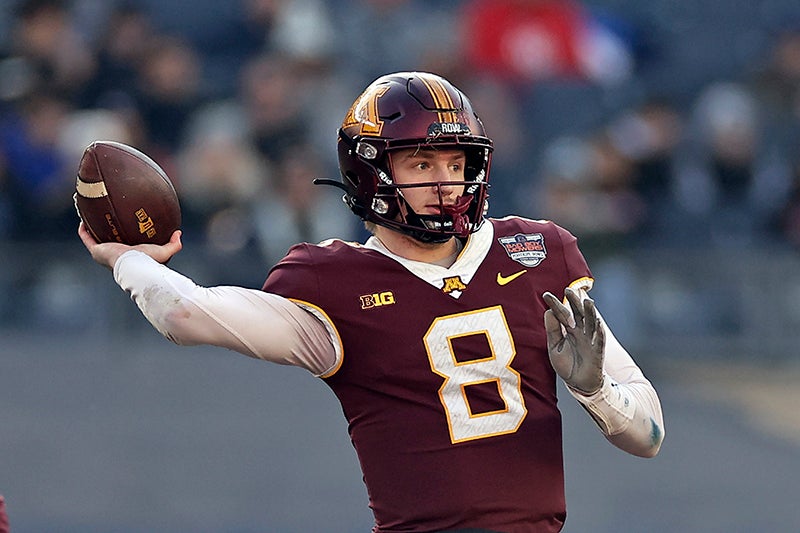Despite seizures, Kill moves on
Published 9:15 am Sunday, December 2, 2012
MINNEAPOLIS (AP) — Jerry Kill was back to work this week as Minnesota’s coach, with players to supervise, a bowl game plan to implement and the constancy of recruiting to tend to.
That’s likely what most of the estimated 2.2 million Americans with epilepsy would’ve done in a similar spot. Kill just happens to have a high-profile job, as the face of a Big Ten football team.
Seizures can be scary, but those who live with them and those who’ve worked with Kill have faith in the coach to persevere, despite three game-day episodes in two seasons at the helm of the Gophers. The latest one occurred in the locker room at halftime last Saturday.
“We all appreciate the fact that this isn’t a normal thing. It’s not something that happens every day. It’s not hiccupping or sneezing,” said offensive coordinator Matt Limegrover, who has been an assistant on Kill’s staff since 1999. “I’ve seen them on numerous occasions, and it still takes my breath away a little bit. There’s concern there. But as a group we’ve worked through it and said, ‘This is a fact of life.”’
The seizure Kill had last weekend kept him off the field for the second half of Minnesota’s loss to Michigan State, but the episode was deemed minor enough that the 51-year-old was able to go home that night without a hospital visit.
The attack he experienced last season, though, is still etched in the minds of those at the stadium and watching on television that afternoon when his body convulsed back and forth after he collapsed on the sideline. That was considered a grand mal seizure, and he was away from the team for several days that month while doctors tried to bring his condition better under control.
The university was well aware of his history with seizures when he was hired two years ago and received medical assurance they won’t hinder his work, and that’s still the message from the athletic department, his staff and Gophers players.
“He’s as healthy as a horse, as they say,” athletic director Norwood Teague said. “He has to continue to monitor all the simple things in life that we have to monitor, in that you watch your diet, watch your weight, watch your rest, watch your stress.”
Teague said he’s not concerned about Kill’s ability to stay on top of this demanding position or the possibility that devious opposing coaches will use it against him in recruiting competitions.
Even if there was such a movement at the school to get out of Kill’s contract because of missed time, firing him for epilepsy would be illegal. Epileptics are protected from discrimination by federal law under the Americans with Disabilities Act.
And plenty of epileptics have thrived in high-profile, super-intense professions like Kill’s. Former NFL players, center Alan Faneca and cornerback Samari Rolle, were picked for Pro Bowls. Outside of sports, the roll call of famous people who have had symptoms of the condition includes presidents James Madison and Teddy Roosevelt.
“There’s still such a stigma. It seems unfair that other medical conditions don’t seem to draw as much scrutiny,” said Vicki Kopplin, executive director of the Epilepsy Foundation of Minnesota, with which Kill has teamed to help raise awareness.
Epilepsy is a tendency of the brain to produce sudden bursts of electrical energy, similar to a power surge, that disrupt other key functions. This can affect consciousness, movements or sensations for a brief time. Anyone who’s had two or more unexplained seizures is medically defined as an epileptic. The condition is normally treated with medication.
Afterward, the person sometimes feels like he or she just ran a marathon due to the strain the convulsions can put on the body. But no cases are the same, and the triggers are mostly mysterious. Stress can be a cause, but university officials and epilepsy experts have continually insisted that there’s no way to guarantee or determine that the stress of Kill’s job makes him more vulnerable.
Brett Boyum, the vice president of marketing for Marvin Windows, is a university alumnus, a Gophers fan and an epileptic himself, as is his son.
“Why are others questioning his ability to do the job, based on health reasons, when we have no reason to believe he can’t?” Boyum said. “He’s talented, and you hate to see something that in my eyes isn’t that big of a deal get in the way of someone’s success.”
The university has not made Kill available for comment since Saturday’s seizure, which came six weeks after a postgame episode he experienced after the Gophers were beaten by Northwestern. He has been loath to talk about how he’s feeling, but his defiance and determination about being able to do his job well came through clearly last year.
“I’m going to go like hell until I go down and when I go down, and they can do whatever they do and I’m going to go again. That’s who I am. And I ain’t changing,” he said then, about 10 days after the grand mal seizure near the end of a loss to New Mexico State.
After going 3-9 in Kill’s first season here, Minnesota improved to 6-6 despite another 2-6 finish in the Big Ten, which on the whole was at its weakest in years. This is a program that counts six national championships between 1934 and 1960 but has only three seasons of eight victories or more (1999, 2002 and 2003) since the last of 18 won or shared Big Ten titles in 1967.
Kill and his staff have a proven record of program resuscitation, but Southern Illinois and Northern Illinois are different breeds than this. The Gophers were blown out by Iowa, Wisconsin, Michigan and Nebraska. Kill took a torrent of criticism when Teague complied with his wish and paid North Carolina $800,000 to cancel a road game in 2013 and a home game in 2014 the coach feared could hurt the confidence of his young players. Then leading receiver A.J. Barker angrily quit the team, accusing the Gophers of mistreating his ankle injury and blaming Kill for not giving him a scholarship.
That’s a lot of bad publicity and Kill’s last seizure made some feel compelled to defend him.
“We didn’t play well against Michigan State, but that really didn’t have anything to do with coach having a seizure,” Limegrover said, adding, “we don’t want to minimize or diminish one. But just like if you have asthma or allergies, there’s a way you approach it. If this comes up, here’s how we move forward. There’s no panic on our staff.”
Kill told the players when he took over about his condition, warning them there might be days when he might be missing.
The players didn’t appear bothered last Saturday. Wide receiver MarQueis Gray said he didn’t realize Kill was even missing until well after halftime.
“I feel more confident since the first time it happened, but any time you see him go down you still have that scare in your head about what’s going to happen,” Gray said. “But coach Kill, he’s been through this more than once and he’s battled back.”
Defensive end D.L. Wilhite downplayed his absence, too.
“Whether coach Kill was out there or not, our jobs don’t change. The calls don’t change. And the team we’re playing don’t change, so we just try to attack it like nothing even happened,” Wilhite said. “I don’t think too many guys have that on their mind.”



